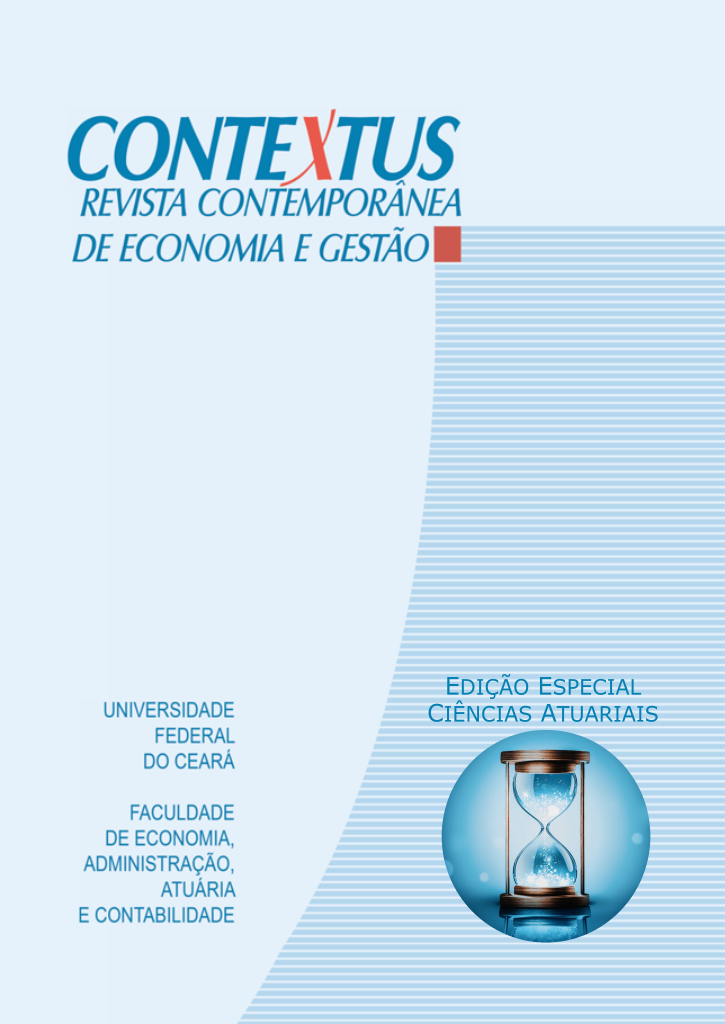Estimating IBNR claim reserves using Gaussian Fuzzy Numbers
DOI:
https://doi.org/10.19094/contextus.2023.83343Keywords:
claims reserve, fuzzy logic, fuzzy numbers, IBNR, estimatingAbstract
The study aimed to propose a new approach to the chain-ladder method using for that Gaussian Fuzzy Numbers. For that, the text introduces concepts and establishes new perspectives that allow not just the use of this kind of fuzzy number in the claim estimation context but also in other areas of knowledge, corroborating, in that way, to the expansion of the adoption of fuzzy logics in a general sense. The results indicates that the adoption of the proposed method offers huge benefits when compared to the traditional approach and previous works exploring other kind of fuzzy numbers.
Keywords: claim reserves; fuzzy logic; fuzzy numbers; IBNR.
References
Andrés Sánchez, J., & Terceño Gómez, A. (2003). Applications of Fuzzy Regression in Actuarial Analysis. Journal of Risk and Insurance, 70(4), 665-699. https://doi.org/10.1046/j.0022-4367.2003.00070.x
Andrés-Sánchez, J. (2006). Calculating Insurance claim reserves with fuzzy regression. Fuzzy Sets and Systems, 157(23), 3091-3108. https://doi.org/10.1016/j.fss.2006.07.003
Andrés-Sánchez, J. (2012). Claim reserving with fuzzy regression and the two ways of anova. Applied Soft Computing, 12(8), 2435-2441. https://doi.org/10.1016/j.asoc.2012.03.033
Andrés-Sánchez, J. (2016). Fuzzy regression analysis: An actuarial perspective. In C. Kahraman & Ö. Kabak (Eds). Fuzzy Statistical Decision-Making, (pp. 175-201). Springer, Cham. https://doi.org/10.1007/978-3-319-39014-7_11
Antonio, K., & Plat, R. (2013). Micro-level stochastic loss reserving for General Insurance. Scandinavian Actuarial Journal, 2014(7), 649-669. https://doi.org/10.1080/03461238.2012.755938
Bojadziev, G., & Bojadziev, M. (1995). Fuzzy sets, fuzzy logic, applications. World Scientific.
Bornhuetter, R. L., & Ferguson, R. E. (1972, November). The actuary and IBNR. Proceedings of the casualty actuarial Society, 59(112),181-195.
Carvalho, B. D. R. D., & Carvalho, J. V. D. F. (2019) Uma abordagem estocástica para a mensuração da incerteza das provisões técnicas de sinistros. Revista Contabilidade & Finanças, 30(81), 409-424. https://doi.org/10.1590/1808-057x201907860
Chakraverty, S., Sahoo, D. M., & Mahato, N. R. (2019). Defuzzification. Concepts of Soft Computing, 117-127. https://doi.org/10.1007/978-981-13-7430-2_7
Christofides, S. (1997). Regression models based on log-incremental payments. Claims Reserving Manual, Institute of Actuaries Volume 2. D5.16-D5.17.
Chukhrova, N., & Johannssen, A. (2017). State space models and the Kalman-filter in stochastic claims reserving: Forecasting, filtering and smoothing. Risks, 5(2), 30. https://doi.org/10.3390/risks5020030
Delong, Ł., Lindholm, M., & Wüthrich, M. V. (2021). Collective reserving using individual claims data. Scandinavian Actuarial Journal, 2022(1), 1-28. https://doi.org/10.1080/03461238.2021.1921836
Derrig, R. A., & Ostaszewski, K. M. (1999). Fuzzy Sets Methodologies in Actuarial Science. In H. J. Zimmermann (Ed.). Practical Applications of Fuzzy Technologies (pp. 531-553). Springer, Boston, MA. https://doi.org/10.1007/978-1-4615-4601-6_16
Dutta, P., & Limboo, B. (2017). Bell-shaped Fuzzy Soft Sets and Their Application in Medical Diagnosis. Fuzzy Information and Engineering, 9(1), 67-91. https://doi.org/10.1016/j.fiae.2017.03.004
England, P. D., & Verrall, R. J. (2002). Stochastic claims reserving in general insurance. British Actuarial Journal, 8(3), 443-544. http://www.jstor.org/stable/41141552
Gonzalez, A., Pons, O., & Vila, M. (1999). Dealing with uncertainty and imprecision by means of fuzzy numbers. International Journal of Approximate Reasoning, 21(3), 233-256. https://doi.org/10.1016/s0888-613x(99)00024-9
Hanss, M. (2005). Applied Fuzzy Arithmetic: An Introduction with Engineering Applications. Springer.
Heberle, J., & Thomas, A. (2014). Combining chain-ladder claims reserving with fuzzy numbers. Insurance: Mathematics and Economics, 55, 96-104. https://doi.org/10.1016/j.insmatheco.2014.01.002
Heberle, J., & Thomas, A. (2016). The fuzzy Bornhuetter–Ferguson method: an approach with fuzzy numbers. Annals of Actuarial Science, 10(2), 303-321. https://doi.org/10.1017/s1748499516000117
Kubrusly, J., Lopes, H., & Veiga, Á. (2008). Um método probabilístico para cálculo de reservas do tipo IBNR. Revista Brasileira de Risco e Seguro, 4(7), 17-46.
Lee, K. H. (2004). First Course on Fuzzy Theory and Applications (Advances in Intelligent and Soft Computing, 27). (2005th ed.). Springer.
Mack, T. (1993). Distribution-free Calculation of the Standard Error of Chain Ladder Reserve Estimates. ASTIN Bulletin, 23(2), 213-225. https://doi.org/10.2143/ast.23.2.2005092
Mano, C. C. A., & Ferreira, P. P. (2009). Aspectos atuariais e contábeis das provisões técnicas (1st ed.). Escola Nacional de Seguros - Funenseg.
Mano, C. C. A., & Ferreira, P. P. (2018). Aspectos atuariais e contábeis das provisões técnicas (2nd ed.). Escola Nacional de Seguros - Funenseg.
Maturo, F., & Fortuna, F. (2016). Bell-Shaped Fuzzy Numbers Associated with the Normal Curve. In T. Di Battista, E. Moreno & W. Racugno, (Eds.), Topics on Methodological and Applied Statistical Inference (pp. 131-144). Springer, Cham. https://doi.org/10.1007/978-3-319-44093-4_13
Shapiro, A. F. (2004). Fuzzy logic in insurance. Insurance: Mathematics and Economics, 35(2), 399-424. https://doi.org/10.1016/j.insmatheco.2004.07.010
Straub, E., & Grubbs, D. (1998). The Faculty and Institute of Actuaries Claims Reserving Manual. volume 1 and 2. ASTIN Bulletin The Journal of the IAA, 28(2), 287-289. https://doi.org/10.1017/s0515036100012472
Wit, G. (1982). Underwriting and uncertainty. Insurance: Mathematics and Economics, 1(4), 277-285. https://doi.org/10.1016/0167-6687(82)90028-2
Wüthrich, M. V. (2018). Machine learning in individual claims reserving. Scandinavian Actuarial Journal, 2018(6), 465-480. https://doi.org/10.1080/03461238.2018.1428681
Wüthrich, M. V., & Merz, M. (2008). Stochastic Claims Reserving Methods in Insurance. Wiley.
Zadeh, L. (1965). Fuzzy sets. Information and Control, 8(3), 338-353. https://doi.org/10.1016/s0019-9958(65)90241-x
Published
How to Cite
Issue
Section
License
Copyright (c) 2023 Journal: only for the 1st publication

This work is licensed under a Creative Commons Attribution-NonCommercial 4.0 International License.
The authors, while doing the submission, accept the notice below:
We authors hold the copyright related to our paper and transfer Contextus journal the right for the first publication with a Creative Commons’ international license of the modality Attribution – Non-commercial 4.0, which in turn allows the paper to be shared providing that both the authorship and the journal’s right for initial release are acknowledged.
Furthermore, we are aware of our permission to take part in additional contracts independently for non-exclusive distribution of the version of our work published in this journal (e.g. publishing it in an institutional repository or as a book chapter), while acknowledging both the authorship and the journal’s initial publication.
We also certify that the paper is original and up to this date has not been released in any other journal, Brazilian or of another nationality, either in Portuguese or another language, as well as it has not been sent for simultaneous publication in other journals.
Last, we not only know that plagiarism is not tolerated by Contextus but also certify the paper presents the sources of passages from cited works, including those authored by ourselves.









3.png)


1.jpg)



1.jpg)


1.jpg)






.jpg)



1.jpg)

1.jpg)


1.jpg)

1.jpg)
1.jpg)
2.png)




1.jpg)
2.jpg)

1.jpg)





1.jpg)


1.jpg)
1.jpg)
